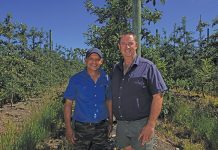Foxy Fresh is a relatively new range of lettuce hydroponically grown and marketed in the East London region of the Eastern Cape. And it’s making a serious inroad to the lucrative organic produce market. Debbie Schmidt, the fresh produce manager of Sparg’s Superspar in Beacon Bay, East London, is full of praise for the lettuce range. “Foxy Fresh outsells all other lettuce in the store,” explains Debbie, who has stocked Foxy Fresh for eight years. “The produce sells itself; the presentation is great and people seem very pleased with it. I even have customers who come from other suburbs to ask for Foxy Fresh. It’s a unique product, especially the lettuce left with the root still attached in water at the bottom of the packet. My customers tell me it has greater longevity.”
The masters behind the product
Foxy Fresh is a father and son business run from the family farm, Flora Farm, about 30km from East London. William Fox and his son Mark have been successfully producing lettuce for 10 years. “We originally farmed pigs, but wanted something different,” says Mark. “were looking for a product that could sell at under R5, but in volume. Input costs of pig feed pushed us towards a new option. got the idea to farm with lettuce while on a visit to KwaZulu-Natal and had the opportunity to see a lettuce operation. Up there at the time, input costs were R500 000 to start up, but knew could do it cheaper.” Mark initially wanted to grow celery, cucumber and tomatoes which are popular crops in his region of the Eastern Cape. But he was looking for a crop with a low selling price. He settled on lettuce.
The fruits of success
At the moment the farm produces garnishing lettuce like Batavia, which is left whole as it’s supplied mostly to hotels and restaurants. Other varieties include frilly lettuce, the green variety lollo biondi and the red variety lolla rosa, butter lettuce, spring onions, coriander, rocket and celery. “My varieties of green lettuce are my best sellers,” says Mark. “They are versatile and can be used as garnish or as a main addition to salads because of the good flavour, whereas red lettuce seems to have a slightly bitter taste making it less versatile.” The Foxy Fresh lettuce range is being sold to the local Spars, Superspar, Fruit and Veg Cities and to wholesalers like Pro Veg and a few hotels and restaurants. “I try to cover risks by increasing the variety of products I produce, so when demand drops for certain products I have back-ups like coriander and celery.”
A dive into the hydroponics deep-end
He confesses that he did very little research before he launched the product range. “Nah, we got lucky,” says Mark. “Too much investigation into something can stop you from doing it. When we first started, a guy told us I would be lucky to sell 500 lettuces a week, but we plant 80 000 seeds a month and green and red frilly lettuce takes six to eight weeks from seed to harvest. There was no niche market when we started, but because we offered a quality product 52 weeks of the year, our product has created its own market. Mark says the presentation of the product has also helped to make it popular. “If the product doesn’t look perfect we don’t sell it. The biggest problem with lettuce is that it lacks longevity, so we improvised. We came up with the idea of selling lettuce with the roots attached.”
The Fox’s hydroponic system works fairly simply. Water is pumped from the dam into a mixing tank where fertilisers and mineral salts are added. Water quality is essential and the dam water has an electrical conductivity (EC) of 0,3μS/cm. After mixing in fertiliser and minerals that comes down to an EC of 1,2μS/cm. “The better the EC in your virgin water before mixing, the bigger the amounts of fertiliser and minerals that can be added, which decreases growth time, and increases plant strength,” says Mark. From the mixing tank, the water is split off into separate tanks that service independent shade cloth tunnels. “Tanks attached to each tunnel again spreads our risk,” explains Mark. “If there is a water-borne disease, hopefully we can isolate it and prevent infection of the whole crop.”
Planting technique
In the tunnels the growing beds are 25m long. They are lined with black PVC sheets and between 750 and 1 000 seedlings are planted in each bed. The seedlings are planted in 9mm road stone (dolomite). White quartz stone is preferable as the white doesn’t attract heat. “Dolomite is what we had so we couldn’t use white shade cloth for the roofs of our tunnels,” explains Mark. “We swapped to black shade cloth, reducing the amount of heat that gets through to the dolomite. We are currently testing red shade cloth.” The movement of the water through the bed is important to ensure individual plants get enough nutrients.
The runoff water at the end of the beds is pumped back into the mixing tank, optimising water and fertiliser usage. “We test our water rigorously, constantly monitoring for impurities and fertiliser and mineral levels,”explains Mark. Cost-effective management Besides the initial set-up costs, other significant expenses are high-quality seed, transport to the market and packaging, which comprises 10% of the turnover. Fertiliser cost has increased substantially lately, but labour is the most significant expense. “We have between 25 and 30 labourers,“ says Mark. “If we had a stable labour pool, I’d be prepared to expand the business, but some labour problems make me hesitant. The labour situation in this area is out of control with the social breakdown, high staff turnover and people not arriving for work, but what can we do? Sometimes labour turns you into a supervisor and labour broker rather than a farmer.”
Value adding Mark advises new hydroponic farmers to produce their own seed as soon as possible. “It adds value to your product and you become skilled at selecting profitable traits and varieties,” explains Mark. “It also gives you production control by allowing you to increase or decrease the amount of seed planted according to the changes in demand on the market. Water quality is very important. We use about 5â„“/m2 every day. Also, consider climate when selecting a location. Lettuce grows optimally at temperatures between 17°C and 18°C and stops growing at about 30°C. “The distance from the market plays a crucial role.
It takes between one and three hours for us to transport our products to the market,” he says. Mark advises that when planting produce, the same bed should not be used too often for the same variety, as this will limit variety-specific disease. Mark stresses that the advantages of hydroponics are that plant density can be higher, the growth is more even, while the growth rate is better controlled. “You‘re getting maximum return on planted surface and generally far greater control over production,” he explains. “It also helps to control the theft factor. However, lettuce isn’t a staple food and it’s also highly perishable.” Farming in the broader sense For new farmers this type of operation could bring great benefit. Not many farmers can afford the initial outlay of buying 2 000ha for more traditional farming methods. Hydroponic farming gives the Fox family the best of both worlds. They have the peace of the farming environment, but also the comfort of the city. Contact Mark Fox on 083 996 6848 or (043) 730 7105. |fw








